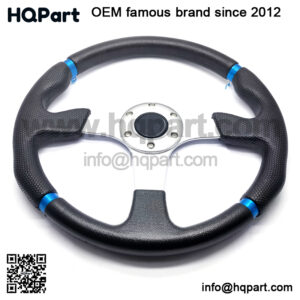Here are 8 signs of steering (or related) problems.
You have a tough time turning the steering wheel
Most cars, trucks, and SUVs on the road today feature power steering. A hydraulic pump (or electric motor in some models) assists the driver in turning the tires when the steering wheel is turned. Old-school vehicles from decades ago did not all have this function and were much harder to steer. Your power steering equipped car would be really hard to steer too if it were not for power assist. If you are having a hard time turning the steering wheel, something is likely wrong with the power steering system. Low power steering fluid in the reservoir might diminish the power assist and is a sign of a leak. A faulty power steering pump or a worn (or broken) serpentine belt could also be the culprit. If your car has electric power assist, a bad motor or blown fuse could be the cause.
You feel a vibration in the steering wheel or your vehicle shudders when turning
Unless you are driving down a washboard gravel road, you should not feel a consistent vibration in the steering wheel and your car should not shudder. If either of those conditions are present, the problem could be with your steering. Worn tie rods – the components that “tie” the rack and pinion (essentially the steering gear or “steering rack”) to the steering knuckles attached to your wheel hubs (and wheels) – can produce the effect of a vibrating wheel or make the car feel like it is shuddering. But either condition could also be caused by a tire that has a bulge or is in need of balancing, uneven brake pad wear, warped or glazed brake rotors. Same goes if your car needs a wheel alignment.
You feel excessive play in steering wheel
If your steering wheel feels sloppy, like you can move it back and forth a bit without changing your direction of travel, there is a problem with a steering system component. The most likely causes are tie rods that are significantly worn and “loose”, or a worn out steering rack. What you should feel under normal circumstances is a responsive wheel that stays centered when you let go on a straight stretch of road. There should be little to no play in it.
Your vehicle pulls or wanders to one side
Just as your steering wheel should not have play, your vehicle should not pull to the left or right on its own. If it does, or if it gradually wanders one way or the other, you could be driving on an uneven road with a significant slope. But if it happens all of the time, everywhere you drive, there is some other issue. Low tire pressure can cause your car to pull or wander to one side. So can uneven tire wear, which is why you should make sure your tires are rotated regularly. A bad wheel alignment can also point one or more tires in the wrong direction and lead to pulling and wandering to one side, as can a faulty brake caliper that is stuck open or closed. If, on the other hand, your car wanders both ways randomly, worn tie rods can be your cause.
You hear noises when you turn the wheel
Loud, unnatural sounds coming from your car can be disconcerting. If you hear screeching or squealing when you turn the steering wheel, the noise is related to the steering system. Low power steering fluid or a faulty power steering pump could be the cause. So could a worn out serpentine belt. If you hear grinding instead, the steering rack is probably going bad. And if you hear a quiet creaking sound, the upper bearings on your struts could be worn.
You notice that the power steering fluid is foaming or bubbling
Power steering fluid is translucent and usually has a reddish tint, similar to automatic transmission fluid. It should not be dark and opaque. And it should not be foamy. If you look in the pump reservoir and notice foaming or bubbles, there is likely a leak in the system that needs to be repaired. It could also be that the fluid is old and in need of replacement (anti-foaming agent is one additive included in power steering fluid and it diminishes out with age). If the fluid has a milky appearance, there could be moisture in the system, in which case the fluid should be flushed using BG services and products.
Your steering wheel “slips” when you turn
There are complaints by some drivers that they turn the steering wheel and the tires do not follow, as if there is a dead zone in the wheel where it has no effect. This is not normal and a car should not be driven if this is the case! Fortunately, this is also not common. If you do notice that your car does not turn when you turn the wheel, or that it does not straighten back out after a turn, your steering rack is in need of repair or replacement.
You feel your car “floating” over bumps in the road
You want your car ride to be comfortable, but not too comfortable. If you drive over bumps in the road and your car floats like a boat on the waves, or bounces like it is on a trampoline, the problem is not your steering, it is probably worn struts or shock absorbers. But worn out struts and shocks can lead to problems while you are steering – potentially dangerous ones.
When you drive around corners, especially sharp ones, the weight of your car leans away from the turn and off of the tires on one side. Your suspension system is designed to counteract this weight transfer to maintain traction. The struts and shocks are integral to the process. So, while they are not a direct component of the steering system, they are interrelated. Old struts and shocks should be replaced.
“Keyword”
“how to replace steering wheel on ezgo golf cart”
“how to replace yamaha golf cart steering wheel”
“how to tighten steering wheel on golf cart”
“how to change steering wheel on golf cart”
“how to remove golf cart steering wheel”
“how to fix steering on golf cart”

